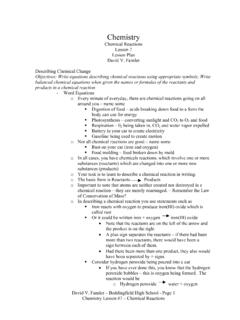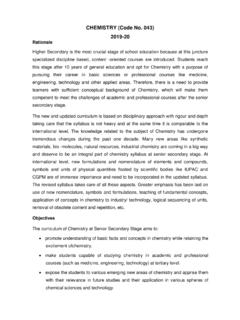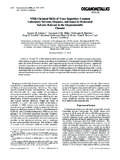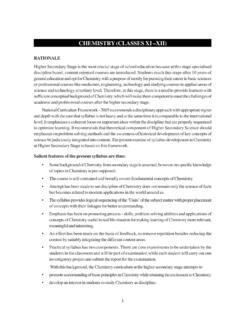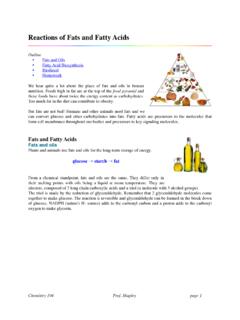Transcription of Atmospheric Chemistry Lecture 1: Chemical Principles and ...
1 Atmospheric ChemistryAtmospheric ChemistryLecture 1: Chemical Principles and Lecture 1: Chemical Principles and Stratospheric Ozone ChemistryStratospheric Ozone ChemistryJim SmithAtmospheric Chemistry Division / Chemical ConceptsBasic Chemical Concepts Chemical composition and units of measurement Reactants: molecules, radicals, ions reactions : primary, binary, tertiary, chain reaction, catalysis Equilibrium Reaction Rates and Lifetimes Photochemistry Dry and wet depositionBasic Chemical ConceptsBasic Chemical ConceptsChemical composition Chemical composition of the atmosphereof the atmosphere The bulk composition of the air ( by vol.) consists of mainly N2, O2,Ar, CO2. These are stable species with little or no interesting Chemistry ! About 99% of the mass of the atmosphere is located below 50 km, in the stratosphere and the troposphere. Because we deal with such trace amounts of material, we have adopted special units of measure to describe the concentration of gas phase Chemical compounds in the atmosphere.
2 Number Density (molecules/cm3) Mass Density (kg/m3or g/cm3). Frequently we use dimensionless volume mixing ratio:whereniis the number density of species iandnais the air number density. and mass mixing ratio:where each now refers to the mass density of species iand of Chemical ConceptsBasic Chemical ConceptsUnits of measurementUnits of measurementaiinn= aii =~ Mixing ratios are usually volume mixing ratios unless indicated, and usually presented as follows: The v in the units refers to volume mixing ratios, which are used so much more frequently than mass mixing ratios that we often get lazy and leave the v off the units. Going from one unit to the next is accomplished by approximating the atmosphere as an ideal gas and then using the ideal gas law:, where p is pressure, V is volume, n is number of moles, R is the gas constant ( L-atm/(mol-K)). You will also need to know Avogadro s constant, which defines the mole as Basic Chemical ConceptsBasic Chemical ConceptsUnits of measurement, continued Units of measurement, continued.
3 Term 10-6 parts per million (ppmv) 10-9 parts per billion (ppbv) 10-12 parts per trillion (pptv) nRTpV= Reactants are individual Chemical compounds that participate in reactions . Several types are important in Atmospheric processes: Free radicals: neutral compounds containing an odd number of electrons. These are highly reactive. The most important free radical in the atmosphere is hydroxyl, which is the combination of oxygen and hydrogen atoms:to form a complex with one unpaired electron that REALLY wants to find another electron: Ions: an atom or molecule that carries a positive or negative electric charge as a result of having lost or gained one or more electrons. Ions are important in the upper reaches of the atmosphere (above 6km, from cosmic radiation), in clouds (lightning from thunderstorms), and in the liquid droplets themselves. , the dissolution of nitric acid in clouds or fog, and is one of the primary contributors (along with H2SO4) to acid rain.
4 Basic Chemical ConceptsBasic Chemical ConceptsReactantsReactantsOHOHHNO3+H2OH3 O++NO3- unimolecular reaction(reaction involving one species), , photodissociationof ozone: The oxygen atom reacts quickly with water to form 2 molecules of hydroxyl in a bimolecular reaction(reaction involving two reactants):The net result of this sequence is the formation of OH from ozone photolysis: reactions 1 and 2 are elementary reactions , that is, they cannot be subdivided into two or more simpler reactions . Together they form a chain reaction. Reaction 1 is the one that started it up, and this is called the initiation step. Subsequent steps, such as reaction 2 and others that may follow are called propagation stepsin the reaction. A chain reaction will end with the formation of stable products (called the termination step):In this reaction, nitric acid is formed in atermolecular reaction(a reaction involving three reactants). M is commonly N2or O2and stabilizes the product through collisions.
5 Without such collisions, the nitric will have so much internal energy that is will fall apart as soon as it is Chemical ConceptsBasic Chemical ConceptsReactionsReactionsO3+h (290 nm < <350 nm)O+O2O+H2O2 OHO3+h H2O+2 OH+O2(1)(2)OH+NO2+MHNO3+MA catalytic cycleis one in which a molecule significantly changes or enables a reaction cycle without being altered by the cycle itself. The example that we will see later today is the catalytic destruction of stratospheric ozone, which is carried out by the following mechanism:Here, the radical X (which can be Cl, NO, Br, etc.) catalyzesthe destruction of ozone and is regenerated in the process, thus allowing for the cycle to repeat over and over .. a little goes a long way ! Basic Chemical ConceptsBasic Chemical ConceptsReactions, continued reactions , continued ..X+O3XO+O2O3+h +O2OO+XOX+O22 O3+h 3 O2 Net: Many Chemical reactions occur in both directions such that the products are able to re-form the reactants.
6 The result is that equilibrium will be established between products and reactants. In the example:Equilibrium can be described by: Note that all reactions have an equilibrium constant associated with them. In the gas phase reaction:The equilibrium constant is about 10140. Most gas phase reactions are like this, that is, they are irreversible. Basic Chemical ConceptsBasic Chemical ConceptsEquilibriumEquilibriumHNO3H++ ][HNO]][NO[HK33== +CH4+2O2CO2+2H2O The speed of a Chemical reaction is called the reaction rate. The science that deals with reaction rates is called Chemical kinetics. A basic understanding of Chemical kinetics is crucial to Atmospheric Chemistry . In Chemical kinetics-speak, unimolecular reactions are part of a class of reactions called first-order reactions : We define k as the reaction rate constant, which is a constant of proportionality between the rate at which A is depleted and the concentration of A, defined as: If we look at the rate at which A is depleted, the solution to the above differential equation is: Where [A]o is the initial concentration of A.
7 In this process, A will have a Chemical lifetime that can be characterized by: Basic Chemical ConceptsBasic Chemical ConceptsReaction Rate LawsReaction Rate LawsAproductsk[A].[A] = kdtd()kt =exp[A][A]ok1= Most reactions in the atmosphere are bimolecular, and we call these reactions second-order reactions . In the reaction:the rate coefficient is defined as: Analogous to the case of first order reactions , the Chemical lifetime of A is defined as: What if you have numerous reactions that compete in depleting A? How do we determine the lifetime of A? We sum up the individual contributions as follows:Basic Chemical ConceptsBasic Chemical ConceptsReaction Rate Laws, continued Reaction Rate Laws, continued ..aA+ +..+.[C]1[B][A][A]1dtdckdtdaba= = bAk[B]1= ..111++= ba Basic Chemical ConceptsBasic Chemical ConceptsChemical lifetimesChemical lifetimesA plot of the lifetime of Chemical compounds in the atmosphere shows a wide variety, from seconds (in the case of free radicals), to centuries (in the case of stable molecules).
8 Also note that the Chemical lifetime determines the spatial and temporal variability of the species. Long-lived gases such as CFCs are well mixed in the troposphere, whereas radicals exhibit much more temporal and spatial variability. Lastly, many reactions aretermolecular, or third-order, reactions . The example given above demonstrates one such reaction: How do we deal with calculating the rates of such reactions ? In mosttermolecular reactions , one compound is present at equal concentrations before, during, and after the reaction. In the example above, the species M is one of these compounds. Since M remains constant during the reaction, we can simplify the kinetics by representing it as a pseudo-second-order reaction:whereAll the rules of second order reactions thus apply!Basic Chemical ConceptsBasic Chemical ConceptsReaction Rate Laws, continued Reaction Rate Laws, continued ..OH+NO2+MHNO3+M[OH]][NO2 = kdtd]M[kk= Don t forget, that in the case of a chain reaction:you need to consider both the production and loss of B when you apply rate equations: Another important concept is that, often, compounds are in steady state.
9 If B were in steady state in the above example, thenBasic Chemical ConceptsBasic Chemical ConceptsReaction Rate Laws, cleaning up Reaction Rate Laws, cleaning up ..Ak1 B +CB+Dk2products[B][D]-[A][B]21 =kkdtd0[B][D]-[A][B]21= =kkdtd One of the unique features of the Atmospheric Chemical reactor is that many reactions are initiated by the absorption of photons of solar radiation. We have already seen and example of this: Just as we defined a rate constant for a Chemical reaction, so too can we define aphotodissociation rate constantJi(sometimes in the vernacular you hear these referred to as J-values, given by: Note the important difference between J values and regular rate constants. In the case of photochemistry, J is not constant but is a function of must be computed for each compound considering the time of day, and altitude. The expression for this is:where i( )is the absorption cross-section of compound i(often given in cm2/molecule), I( )is the photon flux (units of photons/cm2), and i( ) is the quantum yield of the reaction, which states the probability that the absorption of a photon will result in a reaction.)
10 Basic Chemical ConceptsBasic Chemical ConceptsPhotochemistryPhotochemistryO3+h (290 nm < <350 nm)O+O2].[O][O333 = OJdtd( )( ) ( ) dIJiii = minmax For many gases and for particles as well, deposition to surfaces competes with Chemical reaction for the depletion of those species. We will consider dry and wet deposition. Dry depositionrefers to the flux into surfaces in the absence of precipitation (but the surface can be wet), whereas wet depositionapplies to deposition into fogs, clouds, rain, or snow where the gas is incorporated in the bulk solution. In both cases, the relationship between the concentration of species i and the vertical flux, i, to a surface is given by:where vdis deposition velocity of species i with units of, most commonly, deposition velocity is difficult to define by first Principles , depending on: the type of surface (tree, grass, asphalt, etc) Atmospheric conditions (temperature, pressure, wind) the reference height at which the concentration of species iis measured Basic Chemical ConceptsBasic Chemical ConceptsDeposition to SurfacesDeposition to Surfaces][Cvid= i Both can be a function of the solubility of the gas, so an important parameter that dictates the deposition velocity is the Henry s law constant,Hc, for the gas.


